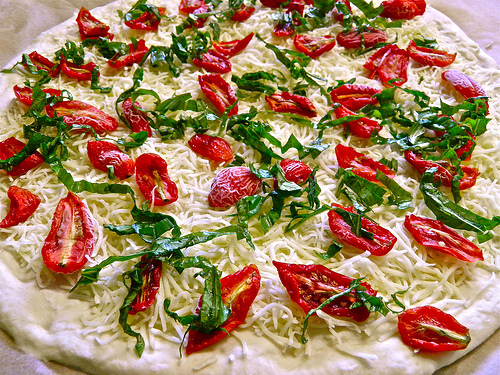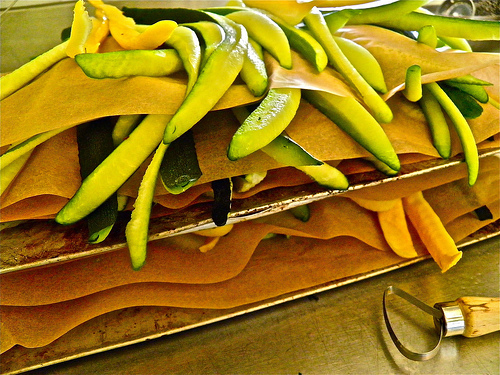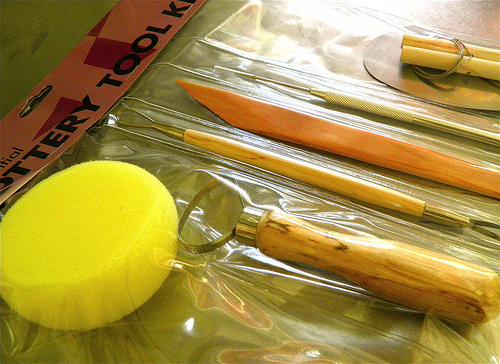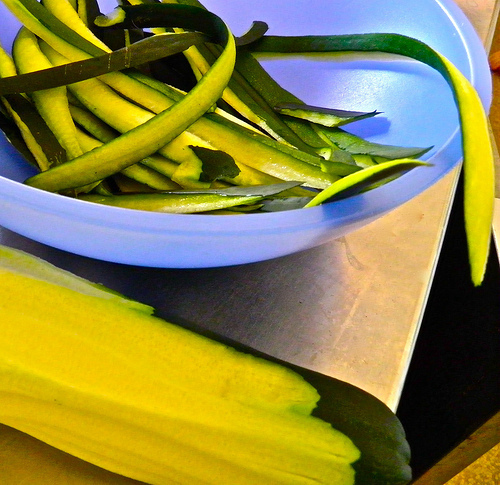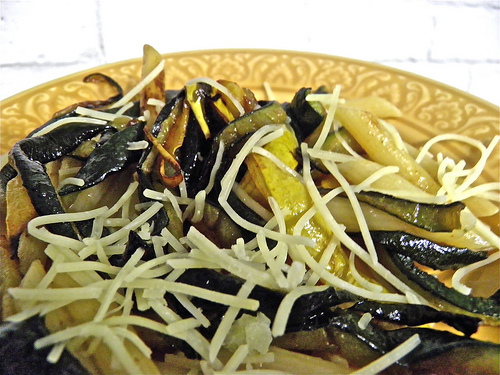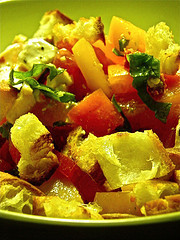Spring Warren's Blog, page 3
September 14, 2011
BEANS
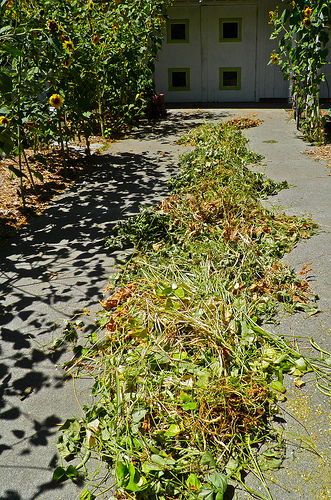
They're all done now – ONE job finished until this job last year. I really did myself proud with the pure volume of legumes I stuck in the ground, then yanked out again. After I yanked out the piles (may I say mountains?) of bean plants I stacked them in my driveway to make my neighbors craz…err, to dry.
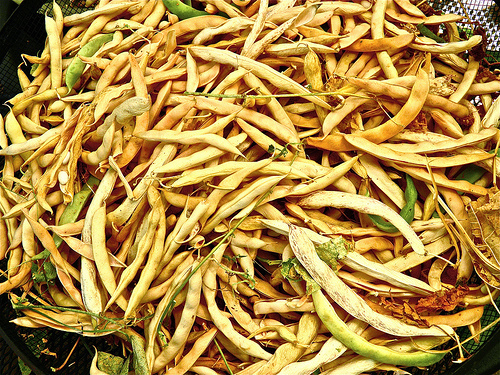
The yanking wasn't finished, not at all – After yanking the bush out of the bed, then I had to yank the pods off the bush.
Followed by popping the beans out of the pods..
And finally, joy of joys, filling up my glass jars with the delectable legumes which fairly hummmm the song of green chile stew!
September 10, 2011
PIZZAS!
This is such a great time of year to make pizzas! The garden practically begs you to reap, roast and throw the proceeds on a bed of dough. Need some ideas for toppings? One of my favorites is sun dried tomatoes and basil with lots of mozzarella.

Try fresh corn and zucchini on a mozzarella base like the Cheese Board does it, then stud the top with goat cheese and drizzle post baking with lime juice.
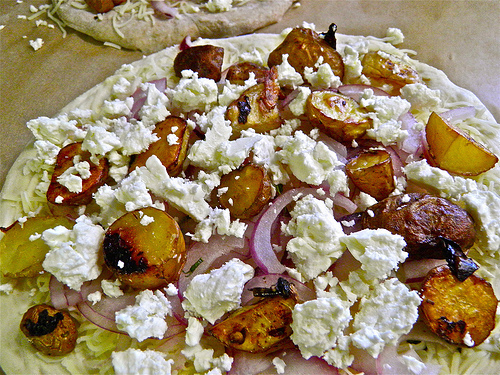
or try potato onion.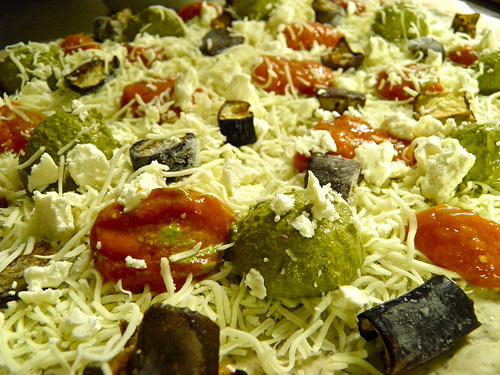
or a comforting roast eggplant pizza polka dotted with pesto and tomato puree.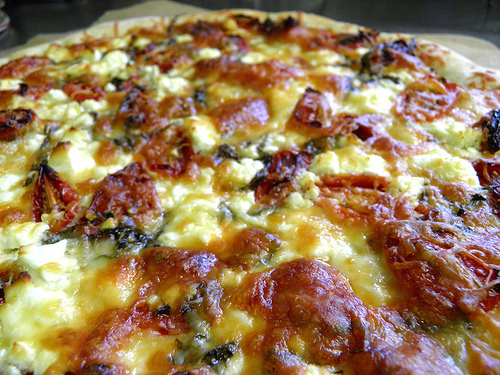
Don't they look wonderful after baking? On pizza night I make personal sized extras for my youngest to take to school for lunch. We freeze them, bag them individually, and he pulls one out in the morning. By the time he is ready to eat the pizza is thawed (but have stayed safely cold in the interim). He pops them in the microwave for a zap, but I like my pizzas cold almost as much as I like them hot, so I'd be happy to eat them as is.
September 7, 2011
The busiest time of year.
Some might think the busiest time of the year is Christmas, but for the Quarter Acre Farmer it is most likely late summer. Late summer is over-lap time. Some plants are producing at their heaviest right now – tomatoes, eggplants, peppers – and they need to be roasted, dried, pureed, frozen.
Others are succumbing to end of the season drama – fainting over mildew, cringing and crackling into old age, fruiting with dementia – you should see the weird watermelons I've got in my garden.
All of the spent plants must be eradicated (bwa haha!) the soil amended with leaf loam, bunny berries, compost, coffee grounds and the like, before the winter crops are put in.
WHAT? You haven't put in your winter crops? Get cracking! (I'm talking to myself by the way).
I have put in some winter vegetables, actually. There are beds of carrots, snap peas, onions, garlic (sort of cheating because it has volunteered from the garlic I didn't dig up) and beets…however, I still don't have my cruciferous plants in – broccolli, cauliflower, cabbages.
Uh-oh, I'm heading for bonsai veggies if I don't get a move on.
In the meantime, I'm drying and roasting and freezing like crazy. (See my pallet of zoodles ready to go into the freezer? YES, ZOODLES FREEZE BEAUTIFULLY. Just let them thaw and drain before broiling to release that extra moisture) Along with all the work, I am also happily munching plums, figs, tomatoes, cucumbers right off the vine. Mmmmm. Why can't it be summer forever?
August 16, 2011
I'M GOING TO THE WINTER'S LIBRARY, TOMORROW!
THANK YOU, DEBRA DEANGELO!
Spring Warren transformed her yard in a typical Davis neighborhood into her own micro-farm. Kami McBride learned to grow and harvest her own plants and herbs to keep her family healthy.
What do they have in common? Both were dissatisfied with how things are and embarked on a path to find another option. And, both will appear in Winters together for the first time on Wednesday, Aug. 17, to inspire others to take gardening to the next level.
Their free talk begins at 6 p.m. at the Winters Community Library, 708 Railroad Ave., and everyone is welcome.
With Warren's strategy of making use of every inch of space surrounding the home, and McBride's strategy of growing and harvesting medicinal plants and herbs that are often native to this area and grow easily, together they will strive to show home gardeners how to "use their gardens in more ways than you imagined possible," McBride says.
McBride will be familiar to many as the leader of hikes at Stebbins Cold Canyon Reserve, where she teaches about the abundant native vegetation that can ease all sorts of aches, pains and rashes, or can be transformed into healthful teas and syrups that alleviate congestion, stomach aches and allergies.
Simple plants that grow wild everywhere in the region — like oat grass, dandelion and elderberry — are practically a free pharmacy and can be grown at home, she says.
In addition to leading the hikes, McBride teaches a yearlong course on herbal medicine, and is certified as a continuing education provider for the California Board of Registered Nursing. She also teaches a variety of other classes ranging from making skin lotions and oils to edible gardens, and even intensive classes focusing just on tomatoes or teas.
She is the author of "The Herbal Kitchen," which features 250 healthful recipes for herbal oils, salts, vinegars, syrups, pestos and smoothies.
McBride became interested in herbal medicine in the early 1980s, following the death of a friend who died from complications from asthma medication.
"A couple people in my life got very sick taking pharmaceutical drugs," she says, adding that her friend was only 21 years old when she died.
She started doing her own investigations into medication and natural remedies, and decided, "There's got to be another way. We've got to do something different."
At the time, she'd never even heard of holistic health care, and now she's an expert on the topic.
McBride was 23 when she set off on a journey all over the country to learn everything she could about herbal medicine, spending seven years on the road just gathering knowledge. One of those years was spent living on an organic farm to allow her enough time to learn about plants and herbs in depth, and learning how to grow the herbs that could be used to make medicine.
"I became steeped in herbal medicine-making," she says.
Her quest for knowledge for her own sake evolved into working with others to self-treat their ailments, and this eventually led to teaching classes professionally. McBride's goal is to "empower people to use herbs in everyday health and home health care."
McBride has seen with her own eyes the power of herbal medicine. Her young son has never been on antibiotics, and she says his asthma symptoms were eliminated using natural teas and steams.
"It's a lot of work," she admits.
Besides treating her son's health issues using herbal medicine, McBride says she is teaching him at the same time about the herbs and what they do.
"He knows that's our inheritance," she says. "A hundred years ago, when someone got sick, you went into your yard and picked something (to take care of it)."
This dissatisfaction for the nutritional status quo and the desire to find an alternate path are what also motivated Spring Warren to tear out both her front and back yards, and set off on a goal to grow or raise 75 percent of her food right there on her quarter-acre Davis residential lot. This was the inspiration for her book, "The Quarter-Acre Farm."
Like McBride, although Warren sought another way to stay healthy, she didn't have an extensive gardening background, let alone one in farming, even on a small scale. She learned everything, literally, from the ground up.
Her inspiration came while she and her husband were on a cross-country road trip. It was the year of the big "salmonella scare," she says, when people were getting sick possibly from eating salads, and the actual culprit for the breakout was under investigation.
Tomatoes, onions, peppers — everything was suspect, she says. Then she noticed what was passing by the car window.
"We were driving though the farmlands, and so much was corporate. We were seeing things sprayed," she recalls.
Warren also noticed feedlots and livestock yards, and started thinking about the salmonella outbreak, and how consumers don't really know what's been sprayed on their food or fed to the livestock. It dawned on her that if she grew her own food, she'd know exactly what was going onto her family's dinner table.
But she didn't really know how. The only thing Warren had ever grown herself was tomatoes — a "hobby garden." But she didn't let that stop her.
"I could grow more," she thought, and announced to her husband and son that she intended to produce 75 percent of their food herself, right there at home.
How did they react?
"They were horrified," she says.
Warren got started by covering her lawn with cardboard and paper, piled with "huge amounts of mulch." Rather than ripping the lawn out, her course of action was to smother the lawn with mulch, which required an ample supply. She learned to catch the sound of chain saws, mowers and grinders in the neighborhood and ask for the debris.
Besides transforming her lawn into usable farming space and planting fruit trees to satisfy her self-admitted sweet tooth, Warren also learned to raise chickens, and had to learn to freeze and can what she grew. Right from the start, she learned what grows really well in this area.
"The first month was the month of zucchini," she says.
Despite these successes, it looks much smoother in print than in reality.
"I had problem after problem after problem," she admits, and had to learn why some things grow well and some don't, and why, and also had to figure out what caused her various failures and try again.
"I had to figure out the science of it, like that potatoes need cold weather," she explains.
After a year's worth of sweat-education, Warren met her goal. Seventy-five percent (by weight) of everything her family ate came from their own garden. So obsessed was she with this goal, she admits that it extended beyond eating at home. She kept track of what she ate in restaurants or at other people's houses to make sure the 75 percent was an honest figure, and says sometimes she brought her own food to other people's dinner parties if the percentages were getting too close.
Although Warren and McBride share many common threads in their quest for healthier living, and although both live in Davis, they'd never actually met until the opportunity arose for them to combine their knowledge and present it to others interested in healthy living choices.
It was a hot summer day when they met at Warren's house, which wasn't hard to spot in a neighborhood of neatly mowed and landscaped front lawns. Warren's is a riot of towering sunflowers, grape arbors and squash beds. The back yard is more of the same, with paths leading to raised beds, vegetable patches, fruit trees and a chicken coop, which is shared with a curious, charismatic white goose that waddles along the fence line to keep an eye on visitors.
The two talked about their histories and viewpoints, and then strolled through the back yard, McBride occasionally pointing to a "weed" and noting the medicinal value to be had for free.
As they shared gardening tips and stories, successes and failures, a synergy began to emerge. This is what they will share with those who attend the Aug. 17 talk.
There is no charge to attend, and there will be a question-and-answer period, too. Copies of "The Herbal Kitchen" and "The Quarter-Acre Farm" will be available for purchase and signing.
For more information about McBride, visit her website, www.livingawareness.com.
For more information about Warren, visit her blog,www.thequarteracrefarm.com.
For more information about the visit of the "garden goddesses" to the Winters Community Library, call Toni Mendieta at (530) 795-4955.
— Reach Debra DeAngelo at debra@wintersexpress.com



August 12, 2011
Easiest, best tomato sauce ever!
To make this sauce you need three categories of ingredients, the first of which is- I'll bet you guessed – tomatoes.
The second category I call something sweet (ish). Something sweet takes the edge off the acidic tomatoes. The sweetness could come from a traditional ingredient like carrots, or it could come from pears, tomatillos, or a couple of plums.
The third thing is herbal/spicy ingredients. Think; onion, red pepper, garlic, chiles, basil, rosemary, savory, sage…etc.
The only rule as to what amounts of what to use is – at least 2/3 tomatoes, and the rest is up to your taste.
Here you can see I used two colors of tomatoes, tomatillos, and onions in my mix. (Notice all of the vegetables have been pierced or cut because I hate it when boiling hot tomatoes explode on me) I put it all in a roasting pan, set the oven to 450 degrees then put the whole shebang in the oven after the sun goes down and the day cools to evening.
I set the timer to 20 minutes. When it goes off, I stir. Set the timer again. Repeat, repeat, repeat until what did look like lovely vegetables now looks like pure glop. I turn the oven off, go to bed.
In the morning I ladle the cool glop into my vita mix blender and blend. Sometimes I add a bit more herbs, or some olive oil…but mostly I don't.
I end up with a beautiful huge bowl of fresh (oh, so, delicious) tomato sauce.
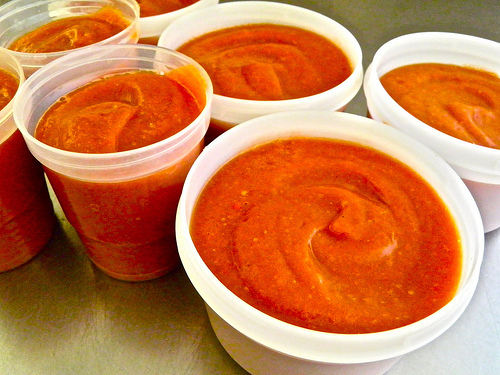
I ladle the sauce into my reusable cups, sign, seal, and pack them into the freezer.

If I have enough yellow tomatoes all at once, I love making a yellow tomato sauce. I make sure I use color appropriate herbs when seasoning it. A big handful of basil in this one and you'll find you've got lime colored sauce. Therefore, instead of green herbs I use white onions, red pepper (gives it a lightly orange color) and garlic.
August 11, 2011
Come one, come all!
Cool Davis Initiative invites you to reserve now.
A Sustainable Living Workshop:
How Much is Enough?
Is it possible to live an ecologically balanced life that unleashes personal creativity, fosters social action, and connects us to the natural world in which we live?
Featuring
William Powers
National Best-selling Author
of
Twelve by Twelve:
A One Room Cabin Off the Grid & Beyond the American Dream
A Workshop With Lecture,
Slide Show, Breakout Groups, and Refreshments
Plus Special Guest: Spring Warren, Local Author of the Quarter Acre Farm:
How I kept the Patio, Lost the Lawn, and Fed My Family for a Year
3 – 5:30 p.m.
Sunday, August 14, 2011
Fellowship Hall, United Methodist Church
1620 Anderson Road, Davis
Suggested Donation: $10-25, and bring your own cup.
Reservations: http://cdihowmuchisenough.eventbrite.com
Co-sponsors include: Church & Society Committee of Davis United Methodist Church, Green Sanctuary of UU Church of Davis, Stewards of God's Creation of Davis Community Church, Unity Church, Lutheran Church of the Incarnation, and others. A Zero-waste Event.
August 1, 2011
Zucchini Noodles!
Why are these pottery tools in my kitchen? Because I cannot seem to keep track of my zucchini. They go from pinkie size to the size of my forearm in a blink – and there is only so much zucchini bread one can make.
As I well know, even big zucchini is delicious – I just have to get rid of the spongy interior flesh and the big seeds before eating it. Once I've done that – I can cook it up in all sorts of ways…but looking at the monster zucchini gave me an idea which capitalizes on the sheer length of the zucchini. Zucchini noodles! (Zukles? Zoodles?)
I use the trim tool to pare a long strip off the length of the zucchini. It takes a bit of practice not to dig too deeply…and I found that if a giganto-zuke hung around the kitchen a few days its skin got a bit tougher which made it just a little tougher to cut. However, by using my thumb as a depth gauge, I soon got the swing of it.
It works on green zucchini, and also on yellow zucchini. The two colors of squash look great together (though the dark green zucchini are much more nutritious).
Toss them with a little olive oil, some brown sugar,salt, and cayenne pepper…or with citrus juice and rosemary….or with minced jalepenos and tomato….or….
Then broil until the zucchini strips are browning and tender.
I can eat an entire plateful of these things…as is. Here we tossed the zoodles with penne and shredded a bit of parmesan over the top. These are so good I am now encouraging my zucchini to get as big as they like – as big as I like.
July 21, 2011
Geese love cucumbers!
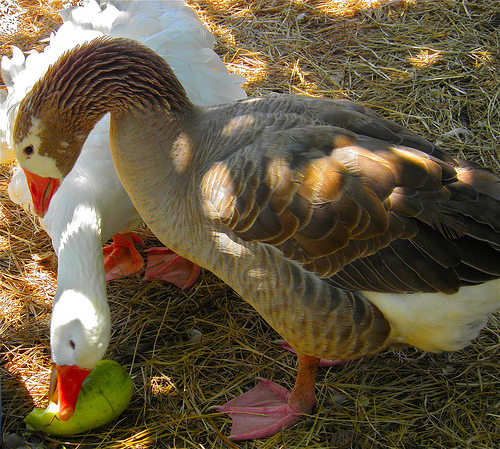
If you'd like to give a goose something fun to do, give them an entire cucumber (such as this monster I found curled amongst the leaves looking more like a giant green larvae than cuke) and let them work on it. Geese love cucumbers, at least mine do – and it is a challenge, albeit a momentary one, for them to gnaw into it. The first bites take a while, then once the skin is broken, what happiness! The cool, green, summery taste of a juicy cucumber makes geese just as happy as it makes me.
July 18, 2011
Three Caprese Salads
It is a bit late this year – the time in which one goes from picking a not-yet-quite- ripe tomato off the vine and hiding it so you can eat it yourself and not share it with anyone, to the time one feels nonchalantly generous with the rich red fruit. (No, I don't hide tomatoes. Some woman I know does, who can be forgiven because it is the first tomato, after all…)
In any case, we're all on the same page now – tomatoes are abundant, delicious, and we're having them for dinner. One of the best ways to eat tomatoes at dinner is as a Caprese salad. Olive oil, balsamic vinegar, fresh, soft mozzarella (if the cheese doesn't feel pillowy soft like you could leave a fingerprint in it, look for a better cheese), basil, and, of course, fresh tomatoes (if the tomato isn't so tender it feels like you could leave a fingerprint in the perfect skin, pick another tomato).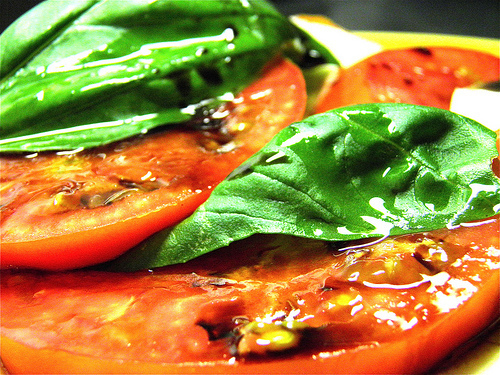
This salad is so perfect and so simple, the only way you can make a substandard Caprese is with substandard ingredients. Otherwise, layer the tomatoes with slices of cheese and whole leaves of basil, then drizzle balsamic vinegar and really good olive oil, to taste, over the salad. I like some salt, but that's just me.
I do sometimes mix one part brown sugar to two parts balsamic vinegar (reducing it on the stove to half). then when cooled, whisking the mixture with the olive oil for a nice bubbly dressing.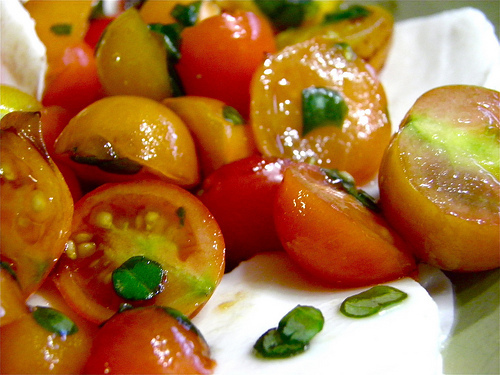
Not only is this salad delicious, it is also beautiful. I love the different ways one can dish it. I made this circle-themed Caprese salad with several kinds of cherry tomatoes, mozzarella balls, and basil dots.
How did I make basil dots? I used a paper punch! Scrubbed the thing really well first, of course, then folded the leaves and punched away. I think a bigger circle would be better, and I know those punches are available in craft stores…so if you've got one, give it a try and let me know how it works.
One more caprese – this one a simple chopped affair, but with the addition of home-made croutons. Cut bread into any size cubes you particularly like, toss with olive oil, salt, perhaps some red pepper, then put under a broiler and stir the cubes several times as they crisp. The difference between home-made croutons and store bought is wide, as is the difference of my appreciation of them.
As for the Caprese Salads – any size, any shape, these salads are the best of summer.
July 12, 2011
Borlotti Beans.
I'm harvesting my borlotti beans and re-planting the vacant beds with more of them. (It's not too late to plant beans if you haven't gotten around to it – and Borlotti Beans are a great dried bean to grow. Sigh. I just loooooove borlotti beans.)
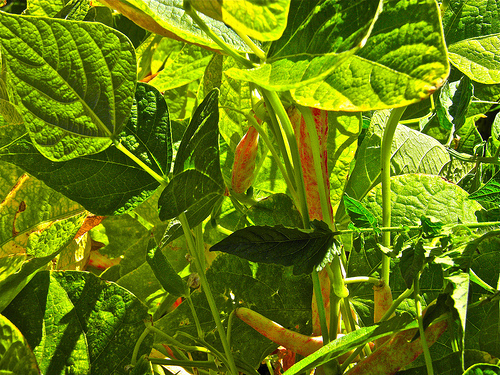
They are also called cranberry beans. About the size of a pinto bean, borlottis are white with a beautiful (cranberry) red veining on both their pods and on the beans themselves. They are my favorite beans because of their warm taste and smooth texture. Because home-grown beans are so fresh (most store-bought beans are well over a year old when you buy them) the dried beans cook quickly and are amazingly tender.
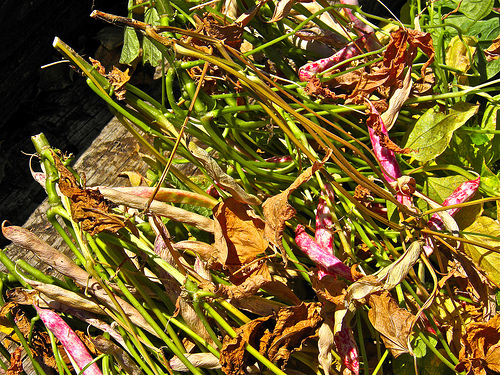
I planted these beans in late April. I waited until the pods were drying and filled with well-developed beans (immature beans will be greenish and have no veining), and the leaves of the plant had begun to yellow. I don't like to wait too long, for if the pods are too dry, they split and drop the beans all over the place as I'm picking them.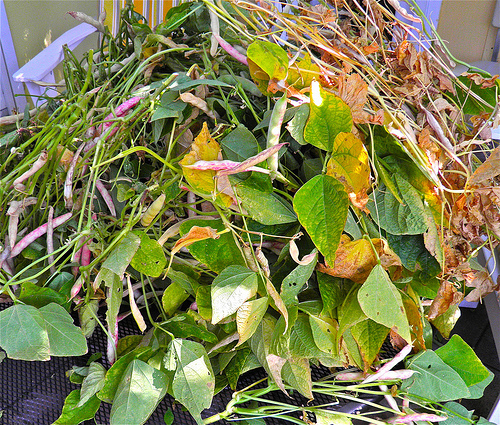
I cut the plants at the stem close to the earth, leaving the nitrogen rich roots to the soil, (stump farming!) then pile the cut plants in a protected area to finish air drying.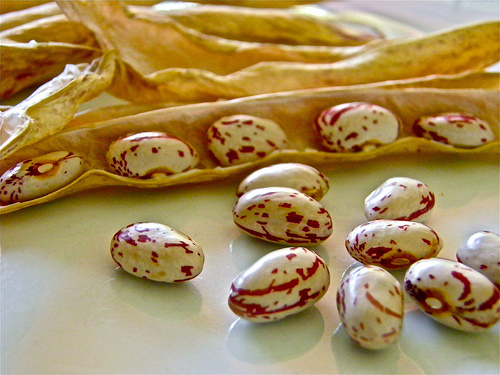
When the pods are dry, they open easily. I let the shelled beans dry until I can no longer imprint them easily with my fingernail, then store them in a glass jar in the pantry with one or two of those sillica packs that I save out of vitamins. I use some of the dry beans for next year's garden, but most – I eat.
Try these beans in a vegetarian (even vegan) green chile stew. You won't miss meat!


